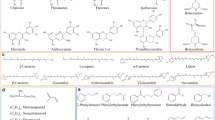Abstract.
The small nematode Caenorhabditis elegans lives in the soil, where mechanical, thermal and most of all chemical stimuli strongly influence its behavior. Here we briefly review how chemical sensitivity is organized at the cellular and molecular level in this organism. C. elegans has less than 40 chemosensory neurons. With few exceptions each neuron senses more than one substance and each substance is sensed by more than one neuron. At the molecular level, as in other organisms, also in C. elegans, seven transmembrane G-protein-coupled receptors (GPCRs), heterotrimeric G proteins, cyclic nucleotidegated ion channels, TRP channels and Ca++ play crucial roles in chemical sensitivity. An unusual feature, possibly due to C. elegans’s strong dependence on chemical cues, is the very large number of GPCR chemoreceptor genes (1300–1700) coded in its genome. Genetic approaches have also allowed the identification of new molecules involved in chemical sensitivity that would not have been discovered otherwise. In addition to the basic factors involved in primary signalling, the studies in C. elegans have revealed a network of regulatory pathways and molecules suggesting that fine modulation of the responsiveness of neurons is important, possibly to allow worms to negotiate a continuously changing environment. The experimental versatility of C. elegans has made it possible, in many cases, to determine precisely in which neuron a given molecule or pathway is required and for which biological response. This type of information can contribute to the general field of sensory signalling because it provides correlations between the biochemical properties of molecules and their cellular functions and between these and the in vivo behavioral responses of the animal.
Similar content being viewed by others
Author information
Authors and Affiliations
Corresponding author
Rights and permissions
About this article
Cite this article
Bergamasco, C., Bazzicalupo, P. Signaling in the Chemosensory Systems. Cell. Mol. Life Sci. 63, 1510–1522 (2006). https://doi.org/10.1007/s00018-006-6114-7
Published:
Issue Date:
DOI: https://doi.org/10.1007/s00018-006-6114-7




